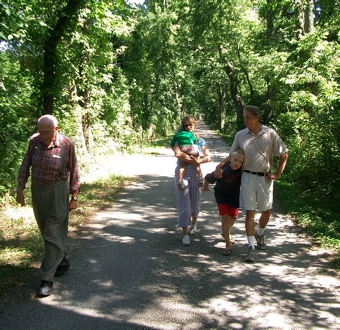Back on the 2nd of the month, friend and former high school English teacher at Crete-Monee High School, G.E. Smith, was the honoree at a big bash celebrating his 80th birthday (which was actually January 2; but out of respect for the majority of humanity that doesn't want to travel to northern Illinois in the dead of winter, he waited until the unbearably hot, muggy days of early July to stage a fete). I didn't make it — new job, just returned from a trip to the Midwest, et cetera.
He had asked me to speak at the event — to be one of a panel of people who would "roast" him. Even though I couldn't go to the party, I made a last-minute stab at writing something for someone else to read. This is it:
***
From a distance of about four or five months, I loved the idea of roasting G.E. What a natural target! The first guy I knew who used a pocket protector! And who *always* carried nine or ten different pens in his shirt pocket — black ink … and blue, red, green, brown, orange, purple, yellow and … invisible.
And yeah, there was his fridge. Stocked with the full array of Ocean Spray products and maybe a pickle jar with just the pickle water still in it and some leftovers that were evolving into new life forms. He had handwritten tags on some jars — an opportunity to exercise his sense of humor. Here's a label — "gorilla beds." "Gorilla beds?" you'd ask more or less innocently. He'd look at you and say, "Ape-ricots."
Get it? And that illustrates another key facet of the G.E. persona: Unashamedly bad punster.
Of course, G.E.'s friends at the E.P.A. eventually declared the fridge a Superfund site — at least that's what the newspaper said. But not before G.E. had demonstrated to his many visitors what he suggested was a genetic capacity to eat old, over-the-hill, and past-the-expiration-date delicacies that he had aged to perfection in the ice box. Maybe he was right. He's still among us to sing the praises of moldy peaches.
So, OK, yes — there's lots of stuff you could pick out from G.E.'s curious existence and roast him for it. His shocking fashion sense, maybe. That's "fashion," in quotes. His taste for homemade recreations like yard golf. His ultralogical grading system, so massively straightforward that he'd have to pull a week of all-nighters to finish his semester grading on time. Maybe his biggest flaw is that he likes to hang out with people like us.
But the more I've thought about it and the closer the day has come, the more I feel G.E. is kind of roastproof. I mean, he's been getting roasted for years and years on a daily basis, and it has never seemed to faze him. Always the teacher, he even sent out a sheet to his "roasters" to suggest sample subjects on which he might be skewered. He helpfully listed 19 topics that might make good joke material, including quote "my philosophical, theological and moral-ethical codes" unquote.
Oh yeah! "Did you hear the one about G.E. and Ahura Mazda! It's a real side-splitter!" There — I was determined to get Ahura Mazda into the mix. G.E.'s a sucker for Zoroastrianism.
Anyway, G.E.'s roast crib sheet was his way of letting us know that anything and everything in his life is fair game so people wouldn't hold back on all the wild stuff they know about him. (He also warned about saying anything risque or using obscenities — but he forgot that we're talking about him. The most risque thing I think I've ever heard about G.E. is that he once failed to change his wiper blades on time. Mort Castle could probably turn that into a tale of terror for us.)
Now, there *is* something wild that comes through about G.E. after knowing him for a few decades — his declining, post-Eisenhower years. But it's not about any of the outward idiosyncrasies that he helpfully proposed as theme topics for his roast. By the way, G.E., you misspelled "idiosyncrasies" on that crib sheet. That's a big F-20 for you.
No, I'd say the wild thing about G.E. is that all that stuff we've been seeing — whether you got to know him as a kid running around Pleasant Hill or in the Navy Seabees or at Illinois Wesleyan or teaching back at Lexington High or holding forth at Crete-Monee or Homewood-Flossmoor or in his codger genealogist years — what we've been seeing all those years is a real, honest-to-goodness person who hasn't been afraid to be himself and to be honest with himself about who he is.
Like I said — always the teacher. And the lesson there is to live up to the injunction, whoever came up with it, to "know thyself." But that's not the wildest thing in his life, or the biggest lesson G.E. has tried to teach us.
No the biggest thing we've gotten from G.E., and the reason I think we're all here with him today, is his unfailing willingness to give to the people around him, whatever they needed, whatever was in his reach to do. Through all the years, that's the constant. He didn't list that as something to roast him about, but there it is.
All I have left to say is: Thanks, G.E.
<p>More on G.E. Smith<br />
<a href="http://infospigot.typepad.com/infospigot_the_chronicles/2006/04/a_teacher_.html " target="_blank">A Teacher</a><br /><a href="http://infospigot.typepad.com/infospigot_the_chronicles/2006/04/a_teacher_2.html" target="_blank">A Teacher (2)</a><br /><a href="http://infospigot.typepad.com/infospigot_the_chronicles/2006/06/test.html" target="_blank">In Which We Gather by the River</a><br />
</p>


